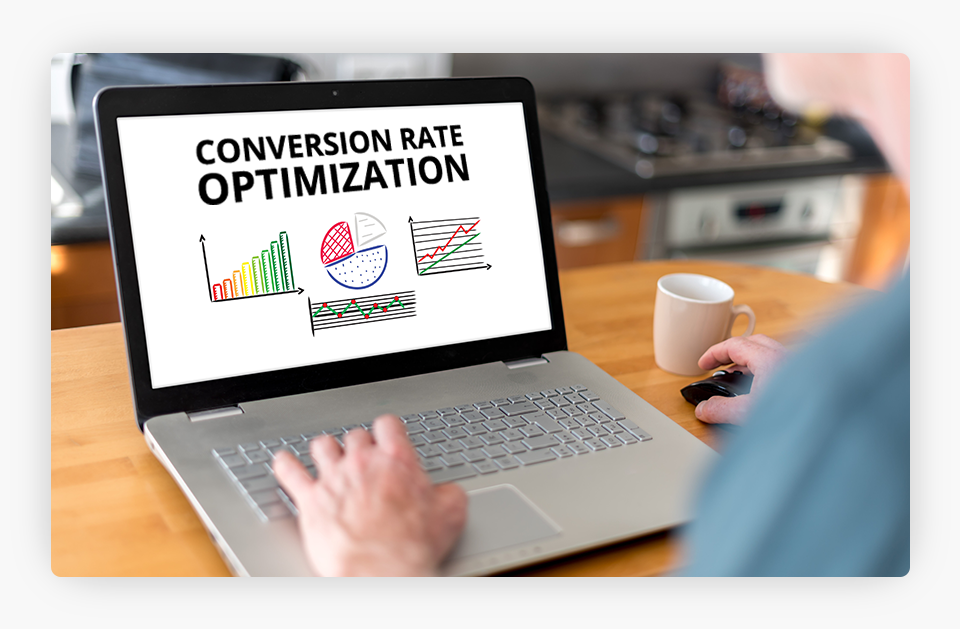We can’t send you updates from Justia Onward without your email.
Unsubscribe at any time.
Understanding your conversion rates can help you streamline and effectively implement your legal marketing efforts, while optimizing your conversion rates can help build your practice and manage costs. Keep reading to learn more.
If you spend any time in the marketing space, you are likely familiar with the term “conversion rates.” In the simplest terms, a conversion rate is a numerical representation of your marketing success. This key metric is part of the larger client journey from a person looking for an attorney, to a lead or potential client, to ultimately becoming your law firm’s client.
If you are familiar with the sales world, you are likely familiar with the sales funnel many teams utilize to evaluate a customer’s journey to purchasing a product. In the legal marketing world, a similar funnel follows your clients’ journey to your firm.
In this funnel, your conversion rate remains an important part of measuring the performance of a marketing asset, such as your law firm website, pay-per-click (PPC) ads, and more. For a law firm, a higher conversion rate directly correlates with an increase in new clients. Plus, understanding your conversion rate, in addition to other key performance indicators (KPIs), can help you identify where you lose potential clients that consider your firm but ultimately do not retain your firm for their legal matter.
The Conversion Rate in More Detail

As mentioned above, your law firm’s conversion rate generally illustrates the percentage of potential new clients that become your actual clients. Likewise, many lawyers analyze conversion rates in other contexts, such as potential clients that become leads, before comparing leads to actual clients. Regardless, the end goal when analyzing your conversion rate is to analyze the success of converting potential clients to the next stage in the process of becoming a client.
Calculating your conversion rate is simple. You compare the desired action (becoming a lead, becoming a client, or some other action) to an earlier action in the funnel that attracts clients (or leads).
For instance, if your firm offers free consultations, you may be comparing the number of consultations in a month to the number of new clients to determine your conversion rate. If you had 23 consultations and got seven new clients, then your conversion rate from free consultation to new client would be 7/23 or approximately 30.43 percent.
As mentioned before, some lawyers want to analyze “conversions” at other points in the new client funnel. For example, a lawyer may consider the number of website contact forms received each month compared to the number of clients they received that month. In this case, if a lawyer received 37 website contact forms and acquired nine new clients, his conversion rate would be just over 24 percent.
Similarly, a lawyer may be interested in analyzing how many website visitors convert into new leads. In this case, if the lawyer receives 926 website visitors and receives 87 contact forms, her conversion rate from site visitors to potential new clients would be 87/926 or about 9.39 percent. Notably, Justia optimizes law firm websites for conversions from site visitors to leads and can help accurately track the numbers at this stage of the funnel.
Over time, you can average these monthly numbers to determine your average conversion rates. Of course, most lawyers want a higher conversion rate because a higher conversion rate ultimately means more clients.
To best assess your law firm’s conversion rate, you want to make sure that you determine how many new clients your firm wants to bring in each month. This goal can help guide your firm’s conversion goals and determine what qualifies as success for your practice.
Keep It In Context: The Conversion Rate + Other KPIs

Remember that your conversion rate alone does not always tell the full story of your legal marketing success. While you should always strive to improve your law firm’s conversion rate, you need to keep this number in context with other metrics and KPIs for a more complete picture of your law firm’s legal marketing success and opportunities for improvement. You want to be sure you are identifying bottlenecks in the new client funnel.
Consider the fictitious law firm of Wynne, Moore, & Case. This firm has a robust digital marketing strategy spearheaded by a dedicated legal marketing team. However, the firm wants to evaluate the performance of new search engine ads it set up with Google Ads.
The overall conversion rate for the firm after a free consultation prompted by this ad is strong but the total number of new clients retaining the firm is lower than desired, especially when the firm considers how many people are seeing its ad. Therefore, the team wants to put the end-stage conversion rate into context and better understand the new client journey through the funnel.
Looking at the numbers, the firm learns their Google Ads campaign has 2906 impressions (times the ad was shown) and received 161 clicks. This means the clickthrough rate or CTR (number of clicks/divided by the number of impressions) is approximately 5.54 percent. This is significantly above the average CTR for search ads, which is often quoted somewhere around two to three percent for all industries and just under three percent for the legal industry.
This ad takes the potential clients to a landing page, where they are prompted to fill out a form requesting a free consultation. Of the 161 visitors to this page, six submitted the form requesting their free consultation with an attorney from Wynne, Moore, & Case. This means that this page only converts about 3.72 percent of potential new clients clicking the ad into viable leads.
However, of the six clients that requested their free consultation, two retained the firm. Meaning that approximately 33.33% of the leads received through the contact form converted to actual clients after a free consultation.
In this case, the firm’s conversion rate does not paint the full picture of whether the new Google Ads campaign is successful. After examining the potential client’s journey through the funnel, the firm can see that there is a bottleneck at the landing page stage that is causing it to lose potential clients the search engine ad brought to the firm.
It could be that the page is not responsive, does not prominently display a user-friendly contact form, or obscures some other vital information. Regardless, it appears that making improvements on the landing page used for the Google Ads campaign may potentially result in more leads through the contact form and, ultimately, more clients for the firm.
This brief example is just one illustration of identifying bottlenecks in the new client funnel. Law firms need to follow their new client journey from the moment they encounter your firm to determine where you may lose leads in the funnel. This can help you both optimize the cost per client you receive (by increasing the total conversions for the same marketing spend) while also growing your practice.
For example, you should compare how many impressions you get versus clicks on any PPC ads you may be running, so you can determine whether your ad is compelling. You should look at landing pages to determine whether your contact information can be readily located. If you are encouraging client phone calls, you need to make sure someone is answering the phone during the hours you run your ads. Likewise, this person should lock the potential new client into an appointment to discuss with an attorney, so that you can increase the odds this potential client remains in the funnel and converts instead of seeking a more available competitor.
In other words, you need to look at several factors at each stage in which a client interacts with your law firm. Your firm should analyze other KPIs outside of the conversion rate, such as the percent of marketing budget allocated for different strategies, marketing cost per new client, marketing expenses as a percentage of the firm’s overall revenue, and more. While we will discuss many of these topics in future Justia Onward blog posts, you can also learn more about various important KPIs for law firms to consider (in marketing and beyond) by reading this post from Clio.
Optimize Your Conversion Rate

While your conversion rate alone likely does not depict a full picture of your law firm’s legal marketing efforts, you ultimately want to bring more clients into your practice. Implementing best practices throughout your legal marketing efforts can help you improve the odds of bringing in leads that become clients. Here are five of our tips for improving your conversion rates:
1. Be Sure It Is Easy to Contact You. Keep your contact information easily accessible on your law firm’s website. Keep your phone number somewhere above the fold on your website, so potential clients don’t have to search for it. You want to be sure that a client could call you in just a few moments, regardless of which page she may be viewing.
Be sure that you also incorporate a prominent contact form on your law firm website and perhaps consider adding email options as well, though this may result in an increase in spam to your inbox. Fully complete your contact information on social media profiles for your firm, as well as on individual attorney profiles in the leading lawyer and legal directories.
2. Be Available. You want it to be easy for clients to contact your law firm. However, you also want them to be able to chat with a real person when they reach out.
According to data from the American Bar Association in 2016, less than 10% of prospective clients were able to actually speak with a lawyer. One out of three callers to a law firm didn’t actually reach a person and 42% of the time law firms took three or more days to respond to voicemails or contact forms.
When someone reaches out to a lawyer, they are often in a stressful and unfamiliar situation. If people in need of legal assistance cannot reach your firm, they are likely to move on to a more available competitor. Combat this by being available.
Consider implementing live chat or chatbot features on your law firm website. Designate someone in your firm, even a non-lawyer, to answer phone calls and screen potential clients. Be sure this person is kind, empathetic, and knowledgeable about your firm. You also want to be sure this person accurately logs information in a database for your firm’s leads. Finally, try to return calls and respond to contact forms as promptly and quickly as possible.
3. Keep Mobile Users in Mind. Smartphone usage is ubiquitous in this day and age. Mobile search has increased in recent years with over 60% of organic search visits occurring from a mobile device in the second quarter of 2021. This means you need to keep the mobile user in mind when optimizing your marketing efforts for conversion.
Be sure your law firm website utilizes responsive design and is AMP-enabled, so it is more readily loaded on a mobile device. Consider implementing sticky elements on your law firm website, such as a header or navigation menu, so that potential clients are always one click away from your contact information. Also, implement features, such as tap to call, that improve the mobile user experience.
4. Focus on Speed. As mentioned above, you need to prioritize mobile users. Something that goes hand-in-hand with prioritizing the mobile user (and desktop users too) is decreasing your page loading times. Speedier load times increase the odds that a potential client will stay on the page.
According to 2017 data from Google, the probability of a bounce from your page by a mobile visitor increased by 32% when page load speed goes from one second to three seconds. When this load time increases to 5 seconds, the bounce probability increases by 90% and at 10 seconds, this probability has increased by 123 percent.
While desktop users may wait slightly longer, nothing suggests they are significantly more patient than mobile consumers. According to data compiled by one digital marketing agency in 2019, the first five seconds of page load time has the highest impact on conversion rates and conversion rates decrease significantly from there.
Additionally, speed impacts SEO and user experience. You can learn more about this relationship between speed and SEO in the Moz SEO Learning Center.
5. Implement Remarketing (Retargeting) Ads. When someone visits your law firm website but doesn’t “convert” into a lead by submitting a contact form or calling your firm, you should take advantage of the opportunity to reach this potential client again. After all, this is someone who has already shown interest in your firm and is more likely to have a legal need.
By using remarketing tools, you can keep your law firm at the forefront of this potential client’s mind and increase the odds that they will ultimately become a client. There are various privacy requirements and restrictions for remarketing that determine whether it is a good fit for your firm. However, it is worth exploring further to determine if your practice is eligible.
To learn more about remarketing options, you can check out our previous Justia Onward post on Facebook Retargeting and Google Remarketing.
Final Thoughts: Why Do You Care?
Understanding your conversion rates and what they mean in the bigger legal marketing picture is crucial to evaluating your law firm’s legal marketing success throughout the new client journey and identifying opportunities to improve while retaining leads in the new client funnel. Additionally, optimizing for increased conversion rates is likely to help you bring in more clients over time, manage marketing costs accordingly, and ultimately grow your law firm more effectively.
If you are ready for effective, experienced help in improving your law firm’s conversion rate and bringing in more clients, our team at Justia Marketing Solutions can help. Our Justia Amplify paid advertising solutions are known to increase law firms’ return on investment and conversions, while our Justia Elevate Websites leverage years of legal marketing and SEO experience to deliver high-quality websites designed to ultimately bring you more clients.
Related Posts